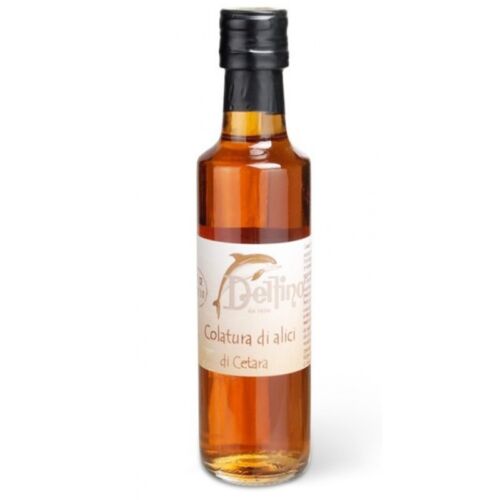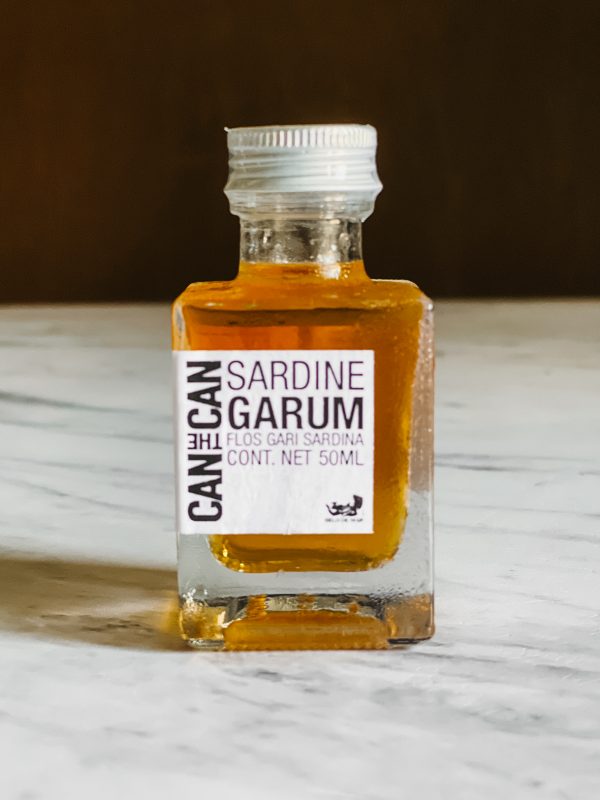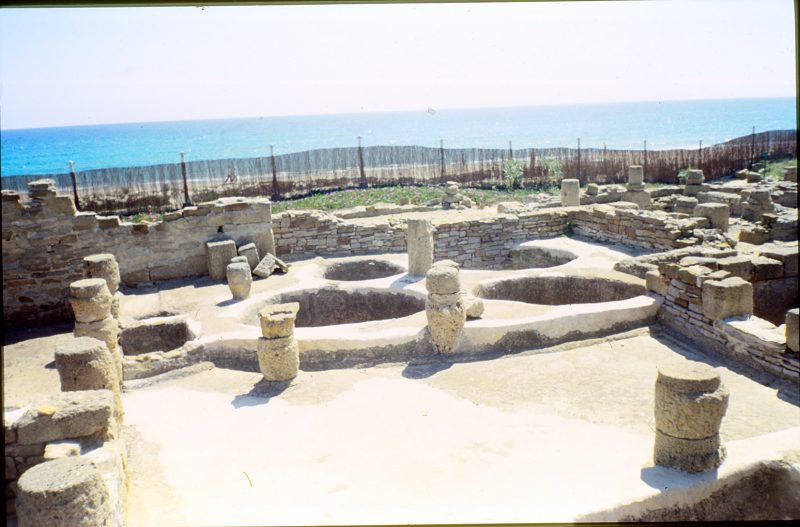Welcome back to A taste of the ancient world . Our film of ancient fish sauce is ready! All I can say is that life gets complicated not just for me but also the for Rod, our wonderful camera man. We have been plagued by gremlins in the film which caused huge delays and we had to call on experts help to untangle it. As I am sure you will agree it was worth waiting for and we simply could not have ditched this version and stated again (we did consider this) as its just too good this way.
Garum Masterclass v1 3 – YouTube
The film explains the basics of fish sauce but in order to catch all who have come here without seeing the film or who are confused by all the different approaches to fish sauce that are out there, here is a very basic Roman fish sauce 101. I have kept the references to a limit but you can find them all in my book The Story of Garum: Fermented Fish Sauce and Salted Fish in the Ancient (routledge.com)
Ancient fish sauce seems to have begun in and around 5th century Greece as a cheap simple fish paste derived from small fish such as sardine anchovy and many related small species commonly called small fry. It was consumed by the poor fishermen and people of similar class and may initially have been cooked but this is not quite clear. If this kind of paste is left to settle it forms into a liquid as well as a paste and it seems that the value placed on the liquid increased so that over time what was considered garos evolved. The liquid garos began to be used alongside oil, wine and vinegar to flavour foods prepared in a 4th century house according to Philoxenus (Athenaeus 1.6a) and it is later described as a ‘tasty cooking liquid’ by Alciphon who is writing about 4th century BC Greek Middle Comedy, though he was writing in the later empire (Grainger 2021: 49). Hellenistic cuisine developed around the idea of blending fish sauces with oil and wine into dipping sauces which were later served largely at the beginning of the meal to tempt the appetite. These compound sauces were called oenogaros, after the Greek oenos for wine. This term is transliterated from the Greek hence oenogarum. These techniques of cooking with fish sauce and also blending sauces formed the basis of a Mediterranean cuisine which arrived in Republican Rome in the late to mid 2nd century BC. This fashionable cuisine was embraced by the elite and aspiring classes in Rome who began to use fish sauce widely and demand high end products from larger species rather then the sauces made with small fry. Garos naturally became garum as the term was simply transliterated. Alongside garos, halmer or a fish brine, later called muria in Latin, was also utilised in Greek sauces and this also came to Rome as part of the Hellenistic cuisine. So far so Good! Garum was now a sophisticated product made from Spanish mackerel, according to Martial and widely consumed at table in the pre-mixed oeneogarum dressings. Pliny tells us that this sauce was nut brown in colour, amber in varying shades dark to light depending on age and as I have discovered varying exposures to light and air results in oxidation which darkens the sauce. Its becoming clear, is it not, that Roman fish sauce is not really Roman and this is at the heart of all the problems modern historians faced in trying to understand the various products gathered under the term garum.
The trade in fish sauce expands exponentially as the demand rises. By the late Republic fish sauce factories in Spain are shipping vast quantities to the bay of Naples and Rome and by the early empire North Africa and Portugal are also producing in quantity. The demand has become widespread and among the middle and lower classes too and particularly the army, as it is through the military supply chain that much of the fish sauce made in Spain and north Africa travels to the military bases in Northern Europe including Roman Britain.
In this frenzied consumption of garum among the masses, the elite were looking for a way to take their fish sauce to another level, and it is that need to differentiate that spurs the notorious gourmet Apicius to oblige by inventing a sauce made entirely from the blood and viscera of mullet (HN 9.66.4). Mullet and eel breeding was a new fad in places like Baiae in the Bay of Naples, attested by the surviving fish ponds. Stories abound of fish breeders treating their fish like pets but ultimately they were bred for the table and the processes involved in cooking these fish seem to have become a little perverted. Dinners, we are told by Seneca, watched the fish swim in a garum seasoned cooking liquor which presumably was brought to a very gentle poaching heat so that, we are told, the colour changes to the skin could be observed (Quaest Nat 3.17.2.9). The fish were then consumed as fresh as possible, the viscera only being discarded at this point. Pliny tells us that Apicius devised a sauce made of mullet blood and viscera but clearly this is material taken before they were cooked. Its name then was garum sociorum . This is variously translated as garum of the allies, or companions, the allies were believed to be the trading groups from Spain who were subsequently commissioned to make this special sauce. This is now unlikely and in fact the term was coined with reference to the dish as first devised by Apicius, that is, a fish sauce generated from mullet blood and viscera was used to add to the cooking liquor that the mullet were cooked in, but also potentially serve with and so ‘their companions’ were just other mullet, served in or with a hydrogarum= water flavoured with garum. This garum was naturally very different from the earlier versions, it was black and bloody according to Galen and had a powerful metallic taste from the iron in the blood and I believe it was unsuited to the basic cooking process. It was, from references in satire, a table condiment which the dinner had some control over. It was also extremely difficult to produce as the process of bleeding fish was not easy as you can imagine. The mackerel, now used to produce this sauce in bulk in Spain – yes it took off despite the odd taste – were caught particularly in Cartagena in the region of Murcia as the mackerel in that region were prolific and a technique of bleeding the fish on board the boat was likely developed, though we are not told precisely how this was done as they are silent on the matter. It would have been sensible to coin a new term for this sauce or retain the sociorum at all times but this is not what happened. The elite appear to have appropriated the term garum with and without a descriptor for this new sauce and a new term had to be coined for the old sauce, which, I am sure you can guess was liquamen. Presumably the manufacturers were either compliant or even complicit in this change of terms. Either way after this change, which we can only loosely date to about 10BC-10AD, ceramic amphora vessels containing fish sauce appear with labels (tituli picti) for both garum and liquamen. Prior to this change there was no need to label fish sauce vessels with complex terms as there was only one cooking sauce alongside the trade in salsamenta ,salted fish which generated the fish brine muria.

liqua(men) flos = unfiltered sauce 
(garum f(los) s(comb(ri = garum of mackerel unfiltered
Written material is slower to recognise the change so we have numerous mentions of garum in texts such as Pliny, Columella, the publication of which span the change but which rely on earlier Greek sources before the development of this kind of garum and clearly mean to refer to the original garos/garum. Garum sociorum doesn’t last very long as we will see below but it does cause problems later as the very fact that a different garum had existed seems to have passed many ancient writers by, while in modern amphora scholarship the distinction between the two sauces is not well understood but is essential in interpreting the amphora labels. Many Greek medicinal and veterinary texts translated into Latin in the late empire did not comprehend the differences while others did so some would translate garos into liquamen, some would translate it into garum. This is the reason why the recipes in Apicius reflect the correct usage ie garos = liquamen as it is clear many of the recipes were originally written in Greek. When indicating fish sauce the recipes use liquamen with barely a mention of garum beyond the compound phrase oenogarum.
For about 200 years garum from blood and viscera was consumed among the elite but did not figure greatly in the wider cuisine of either Rome or Greece. It appears from numerous references in poetry to be far more important than it actually was. It was an odd anomaly in Roman culture, and died out quite rapidly after Christianity spread as the overt consumption of blood was prohibited. Once it had ceased to be consumed generally people seem to have reverted to using garum to refer to the original Greek sauce. I bang on about the distinction in my book and hear because it is necessary to separate the standard whole-fish sauce of daily cooking, utilised by all classes from the sauce that was the epitome of perverted luxury made from fish blood??.
To complete the picture of the development of fish sauce into the Byzantine and medieval period see below.
The most reliable recipe that survives for fish sauce is in a Greek Byzantine agricultural manual called the Geoponica compiled in the 10th century but made up of material that is dated from a much wide period including material from the Hellenistic and Republican periods. Andrew Dalby has produced a good translation Geoponika | Prospect Books. A further recipe from a 2nd century AD Latin agricultural text by Gargilius Martialis is less reliable for various reasons best left to my book (Grainger 2021 18-25). The two sources together give us a good idea of what was involved.
Full recipes here: https://www.atasteoftheancientworld.co.uk/the-geoponica/
Garos/liquamen/garum
Whole small and medium sized fish (anchovy sardine mackerel, cut open unless small enough to dissolve quickly) combined with salt levels that are either low c.12-15% or indeterminant but a good deal higher, They are allowed to disintegrate and dissolved using some little natural heat, indigenous or additional digestive enzymes and time. The result was a liquor and a fish paste called allec. Fermentation takes up to three months, either open to the warmth from the sun where evaporation is regularly replaced with either wine or brine or in an enclosed vessel where no extra liquid is added until after the first sauce is removed. It was possible and even necessary to re-brine the residues to extract 2nd and even 3rd sauces which were not necessarily 2nd quality as this depended on the size of the fish, duration of fermentation and when it was fully filtered as I explain in the film. Both methods result in a rich amber liquid potentially high in protein yet relatively low in salt. The secret to a high quality sauce concerns the length of time that the liquor is left unfiltered of its fish paste. The vessel below on the left contains what I have defined as a flos sauce. Archaeologist and linguists differ as to the meaning of flos. The arguments are best left to the book, but I have demonstrated that the longer the sauces are left together the taste improves due to higher nutrition. The paste effectively continues to dissolve into the sauce as long as they are left together. The sercrte therefore is to not filter until the last minute.
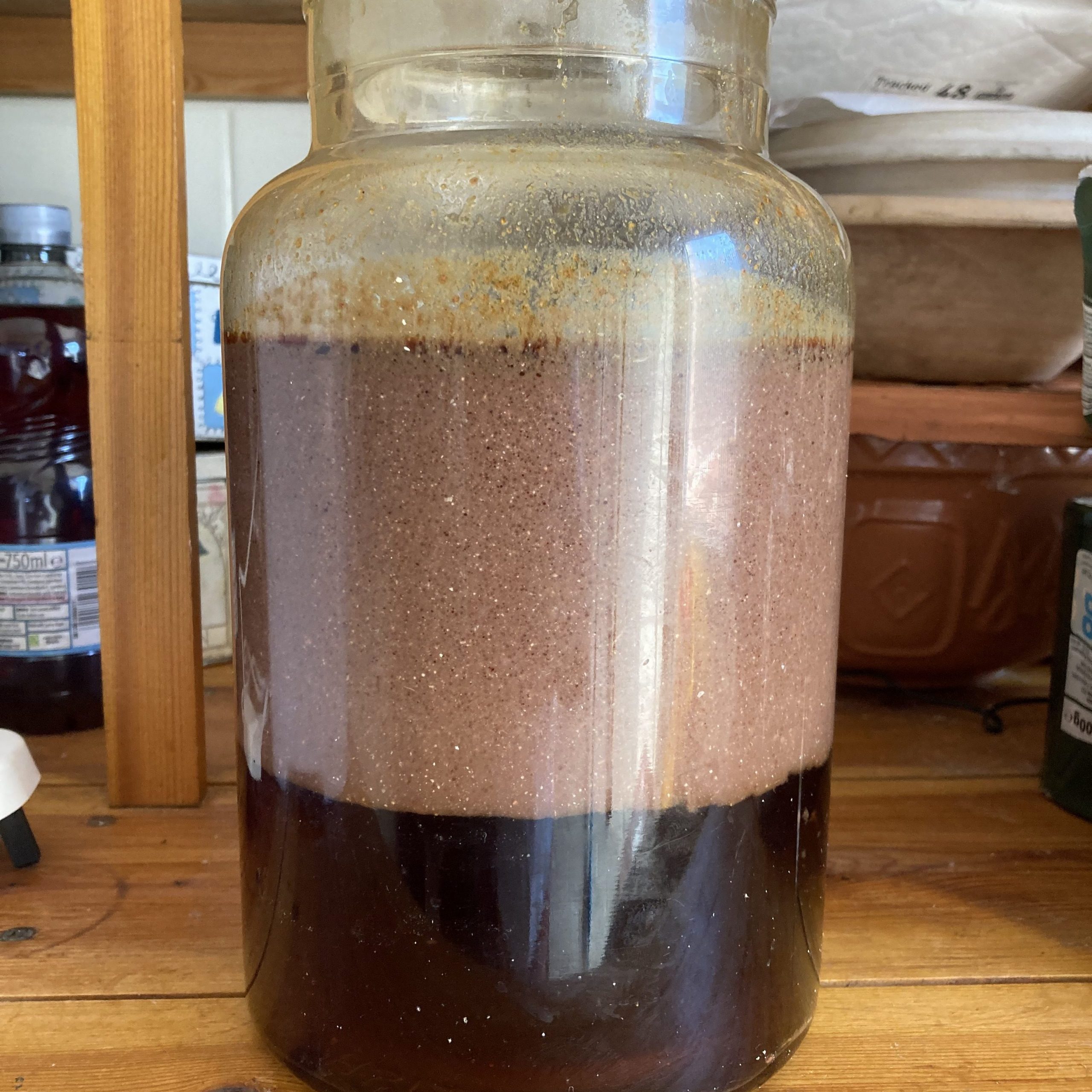
My mackerel fish sauce in its final stages. 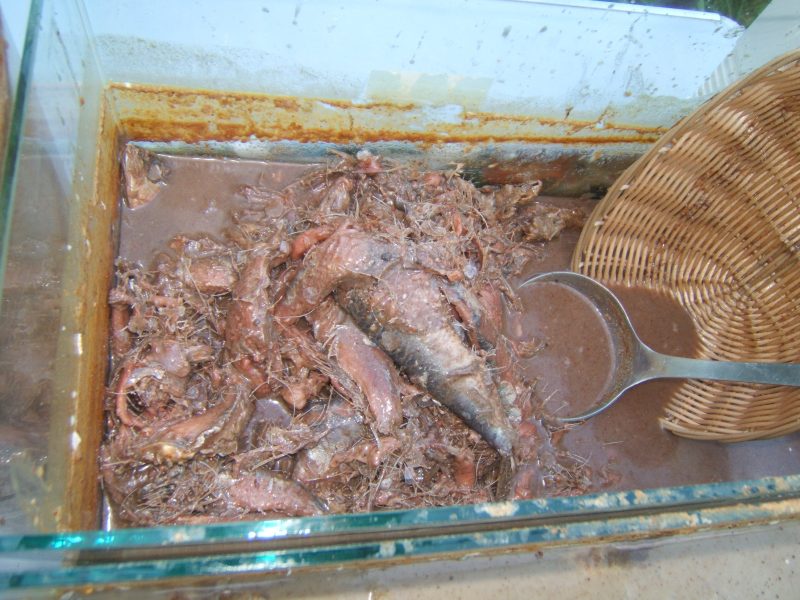
A large batch of mackerel sauce after first extraction
Modern fish sauce substitutes
I now want to deal with the whole issue of what to use in Roman recipes instead of S.E.A. sauces, when you also don’t want to make your own. S.E.A. are now largely inadequate because too strong in flavour, too sweet and too salty. They just disappoint. For years it was all there was but now the options are legion as we shall see
Colatura di Alici
This was traditionally a salted fish brine, a muria in ancient sauce terms, light in colour and taste without the varying levels of intensity of umami flavour that is generated when sauces are fermented whole. As there are no degestive enzymes it is much harder to extract the muscle protein and convert it to a liquid state. This product was made in the region of Cetara and surrounding villages in the Bay of Naples. Initially the anchovy were beheaded cleaned and deboned in one action: Snap off the head of the anchovy and pull down, the viscera and spine with some of the vertebrae comes away and you are left with a nice neat fillet. Its still bloody so it is then mixed with course salt over night to draw out the blood. The liquor that forms: a bloody brine is discarded. The fillets are then washed and layered in a neat spiral in barrels and jars while salt is sprinkled (but not weighed) over each layer. The barrel is covered and compressed with stones and left to age for a varying degree of time, up to three years in some instances and as little as 6/8 months in others. I believe the shorter ferments involved the consumption of the anchovy while the longer involves discarding or reusing the fish in other ways. The liquor that forms was originally used as a local seasoning while the anchovy themselves were consumed separately. It seems that from ancient times there were potentially two different sauces i.e one aged where the fish was not utilised and one much shorter where the fish were consumed or as colleagues have suggested it may be that the process has changed in recent years. It has been suggested that the manufacturers realised there was a culinary market for the liquor and began to change their technique. The sauce was left for longer and the anchovy was not preserved for consumption but every drop of water was extracted from the flesh and in fact extra brine is some times now added to maximise the harvest of finished sauce. Some techniques involve mashing the fish by hand to maximise the extraction while the tradition is to compress only.
Colatura di alici is a clean product with limited fermentation whether from bacteria or enzymes compared to a whole fish sauce and so much of the protein in the fish remains in solid form unless aged. It may be that over the extended aging time most of the protein will be extracted. The flesh of the fish contains less powerful enzymes while bacterial action also contribute to the liquefaction processors. The variety known as Nettuno is aged for three years apparently and as a result probably made the traditional way.

Small batch Colatura being made
The basic recipe is about 120 kg of anchovies, 60 kg salt and yields about 10-12 litres of sauce. This is quite a low yield compared with other sauces. The residue as I hope I have demonstrated in the video would go on to make at least the same amount without reducing flavour.
The aging, maturing and darkening of the sauce resulted in relatively greater umami but as the fish essentially remains solid state we are still dealing with an aged muria. It is entirely possible that ancient muria was also aged for up to three years as we find many labels on amphora associated with mackerel and tuna which do seem to suggest that the fish were aged for that long. I have always questioned how it would be possible or desirable to consume fish aged that long in brine.
Muria becomes garum
This is where it gets very much more interesting. In strict Jewish food laws it was stipulated that fish were supposed to be ritually slaughtered in the same way as meat and the blood drained away and the flesh cleaned with salt, just as we have seen that colatura is prepared, in order to comply with the prohibition on the consumption of any blood at all. These laws were not always complied with even in Roman Palestine as we find that rabbis would often argue about these restrictions. Traditional forms of fish sauce were consumed by Jews and they appear to only want to ensure there was no shell fish involved in the process. The orthodox view was always that the blood of fish was prohibited. In the Roman West this original Jewish prohibition had not taken hold and ceased to be enforced very soon after Christianity began and only persisted in relation to overt consumption of blood from meat animals. However in some Greek, Cypriot and Syrian orthodox churches the prohibition was retained and often enforced. In these circumstances no one ate fresh fish that had not been salted first to draw out the blood. Clearly a traditional fish sauce with retained viscera was obviously forbidden (never mind the bizarre blood viscera sauce – garum sociorum, which of cause dies out precisely because all forms of early Christianity rejected such overt blood consumption). In fact the equally valued muria became the sauce of choice in these communities. So, for orthodox Christianity in the East muria actually becomes garos, as they begin to call it garos. Colatura was therefore also a legitimate form of ancient garum fish sauce and a suitable substitute for it in communities where the whole fish sauce was forbidden. The salt levels of the modern Colatura is always going to be too high for me, but as muria/garos was seemingly used in exactly the same way as liquamen i.e. in larger quantities one needs to just be careful about the quantities you use.
It has taken some time to gather together all the different options that are now available. I currently have at least 6 different colatura di alici, all of which are largely similar to be honest. Light amber in colour, weak in that nitrogen flavour of protein that you would get from a dissolved sauce but high enough in umami and with varying levels of salt. In terms of taste the lower the salt levels the more the taste of the protein is apparent. The one factor that is universal is that it is eye wateringly expensive compared to any S.E.A sauce (South East Asian) and given the yield is so low this is not surprising.
Garum Lusitano
Making umami inside 2,000-year-old ruins – CAN THE CAN
This is one of my favourite sauces – apart from my own of cause! – a fabulous sauce developed through the dedication of a chef called Victor Vicente who runs the Can the Can restaurant in Lisbon. The Sardo river at Setubal has been famous for sardines for centuries. In Roman times the area was known to produce salt and also preserve their fish to trade widely within the empire. Many fish sauce factories were built on a spit of land known as Troia, near to Setubal. Its a serf and beach resort now but in-between the hotels are numerous fish sauce factories

Victor Vicente made his fish sauce inside the original Troia vats while enclosed in large food grade bags. The fish were subject to same conditions and utilised the same kind of salt and sufficiently low that there necessary bacterial fermentation could take place. The process closely mirrored the ancient technique and the result were amazing. It has a light fresh yet rich umami kick with just enough salt to allow you to add a little more of it to oenogarum sauces. He now manufacturers many different types including mackerel and tuna. I strongly recommend Victor’s sauces though it has to be said that the cost at 5.50E per 50ml is expensive but reflects the considerable expertise that has gone into making it. The small glass bottles now come with dropper dispensers which reflects the tiny amounts of sauce that you are expected to consume at any one time and this is not in keeping with the reproduction of a Roman meal which would probably require 4-5 bottles.
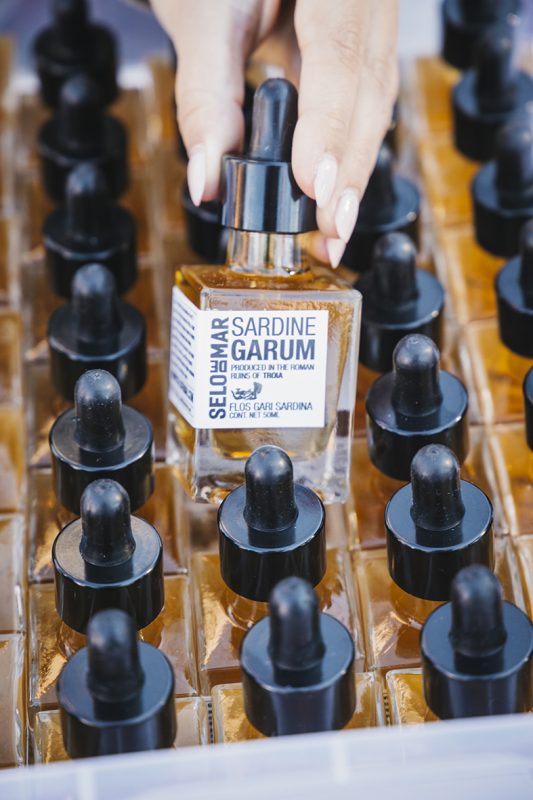
Escata
‘Pere Planagumà culinary career has embraced the most radical of avant-garde gastronomy (El Bulli, El Celler de Can Roca), the finest traditions of classical French cuisine (La Tour d’Argent in Paris), renowned stalwarts of Catalan cooking (Mas Pau, Les Cols) and now his own project, Rom, in Roses. Always curious, always investigating new flavours and preparations, Pere Planagumà has now created Escata, his own version of the legendary Garum sauce’.

Pere Planaguma 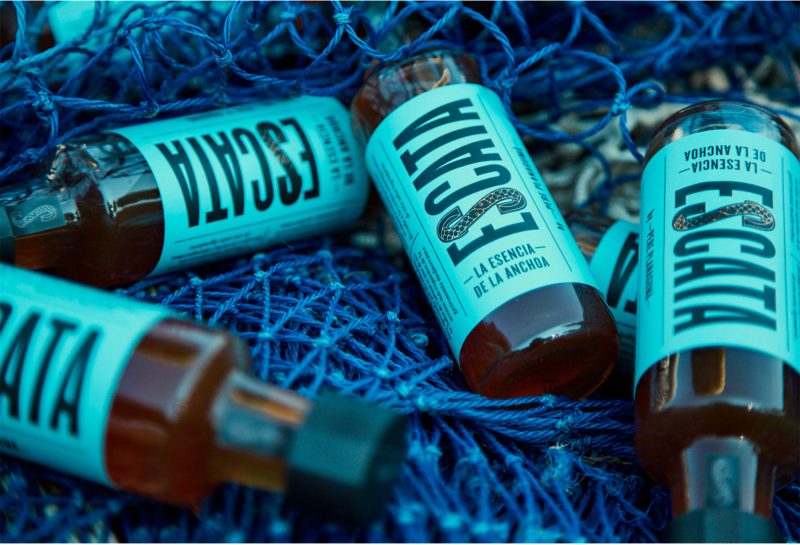
Escata
Pere considers his sauce a true ancestor of the ancient traditions. He has reformulated garum ‘for the modern palate utilising unique and ancient techniques to bring this seasoning to you. Use to add and balance flavour across sweet and savory. An Umami nuke!’ I like that phrase very much. Its described as the essence of anchovy and when I first encountered it, it was made from anchovy waste material which was a major environmental contaminant at the port, where he sourced his anchovy for the restaurant, i.e. the head, spine, viscera and residual blood matter. Based on my definition of fish sauce in the ancient world this is not an authentic sauce but it does generate an umami kick and has some of the more intense flavour associated with a true garum ie a metallic taste. Its great that such waste material is utilised to create a gourmet product yet the costs are reasonable as expected at £5.50 120g.
Flor di garum
This fish sauce is manufactured in a collaboration between the departments of Food Technology and archaeology at the University of Cádiz jointly with the university of Seville. Scholars from Cadiz have been studying the Roman site of Bologna for many years as it was one of the first fish sauce factories to be studied in detail. Fish sauces and salted fish was manufactured there from the early first century AD.
The team of scientists and archaeologist under auspices of Dario Bernal Casasola turned to the Latin recipe attributed to Gargilius Martialis for their fish sauce. This is an enclosed production process that uses whole small and medium sized fish such as anchovy and sardine, quite substantial amounts of salt – the recipe states 2 fingers between each layer of fish, which almost results in a 50/50 ratio that is even higher than a S.E.A sauce – and also many herbs. The resulting sauce is intensely flavoured with umami and protein. It has that ‘umami nuke’ that we heard about from Pere but because of its excessive salt I believe it cannot be used in oenogarum. The team behind it admit that ‘ A few drops of Flor de Garum are enough to flavor a dish’. It is as intense as Red boat in many ways. The Cadiz company El Majuelo in collaboration with Professor Victor Palacios from the food technology Dept. at Cadiz have also begun to experiment with others forms of fish sauce. Flor di garum are now making a true garum sociorum. It is of such a dark hue that it ios clear they have made a true garum with tuna blood. The terminology refers to the red blood colour. I am going to order some and post a separate blog on these blood viscera sauces, so watch this space for reviews!
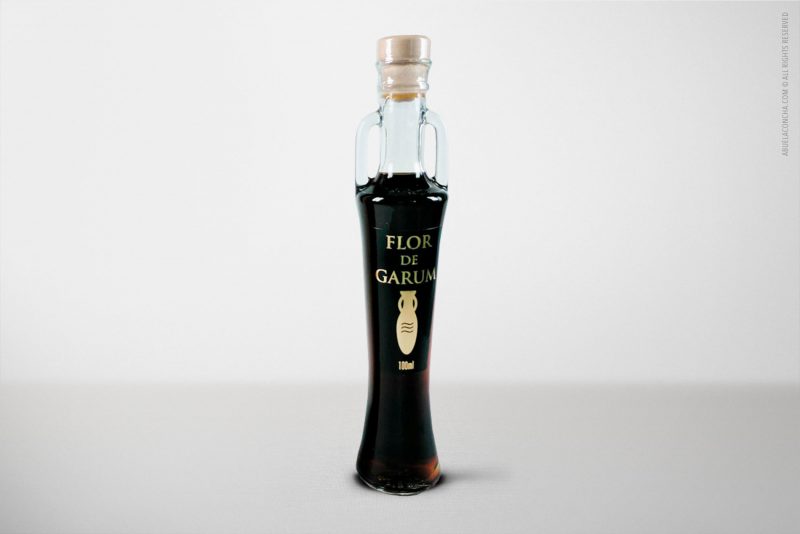
Flor de Garum of Bluefin tuna 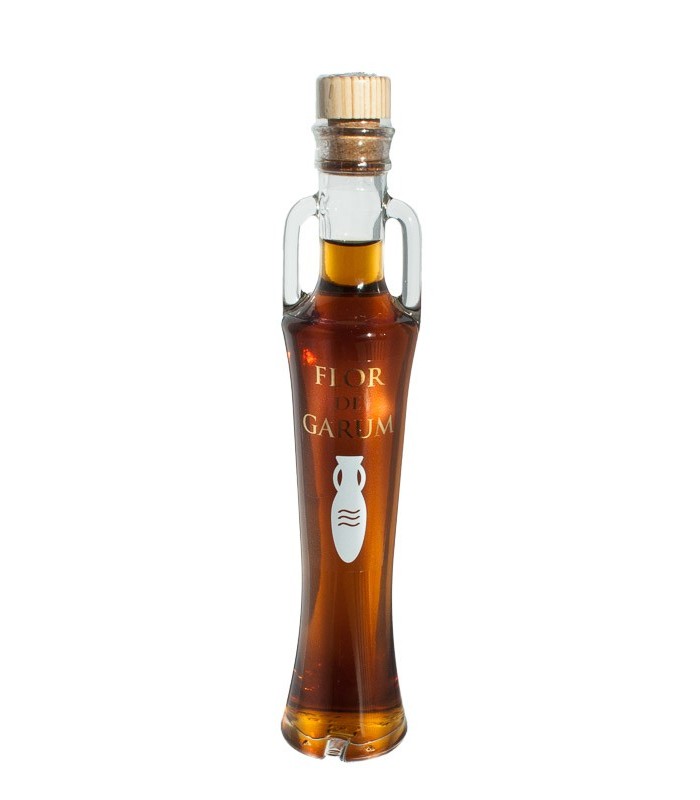
Flor de garum 
The online prices vary a great deal – and for all these sauces too- but my most recent search resulted in 28.90 E per 100ml of the standard sauce , while the dark red tuna variety was 100ml 32,00€. More details about this below.
Flor de Garum Red Tuna ancient sauce Rome 100ml – Arqueogastronomía (arqueogastronomia.com)
Garum di tonno salsa di pesce
Garum of Tuna Sicilian High Quality 100g | eBay
I have just discovered this one made in Sicily by a company called SICILIA BEDDA CAPACI. By its colour and also from the description we are looking at a true garum sociorum. They freely admit that they have used blood and viscera from tuna to make this sauce. An exciting prospect to taste it. Once again watch this space!!


